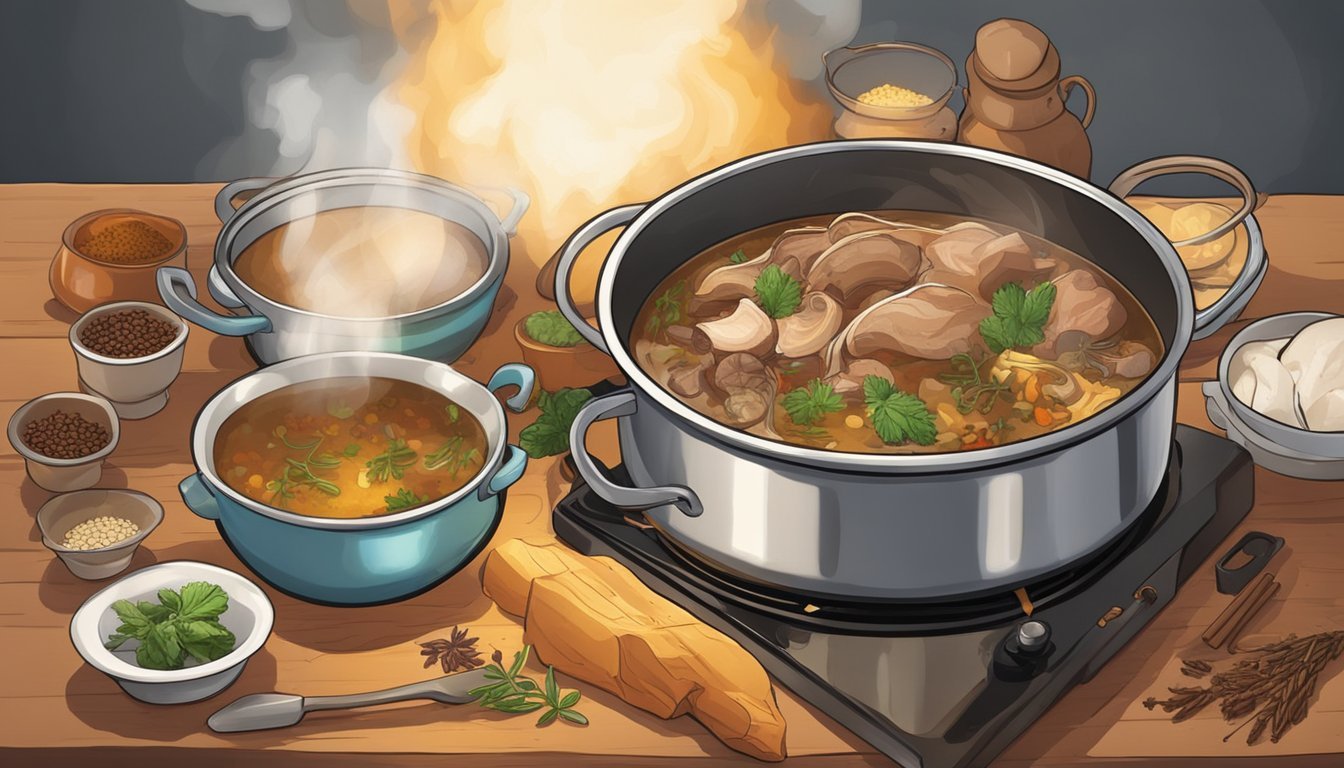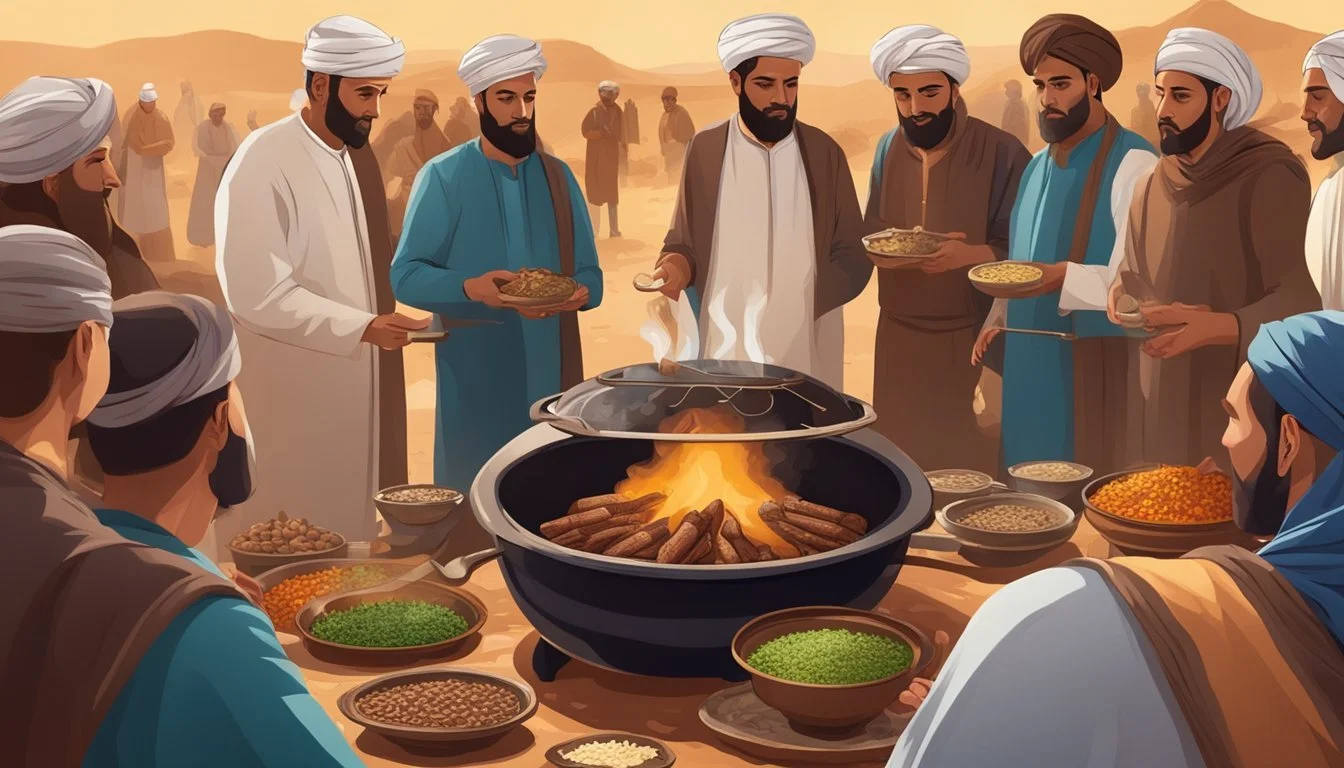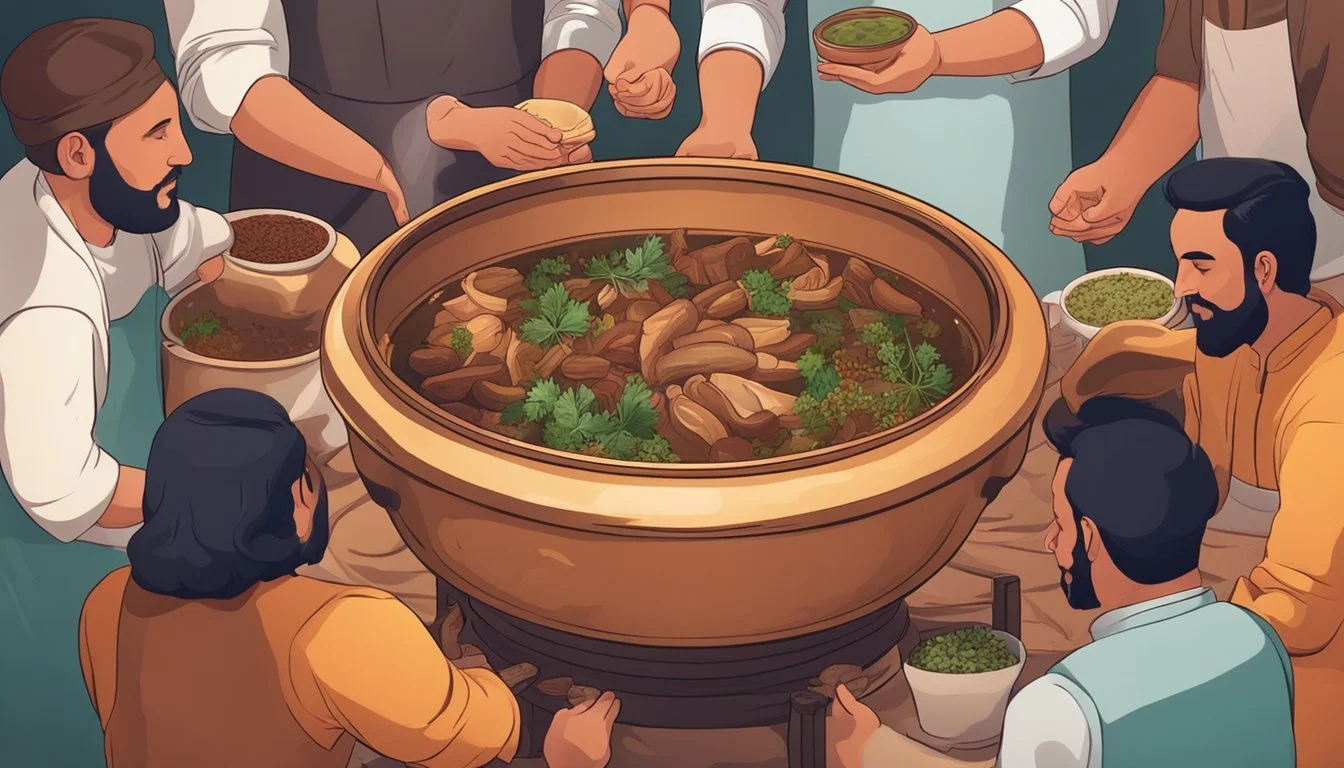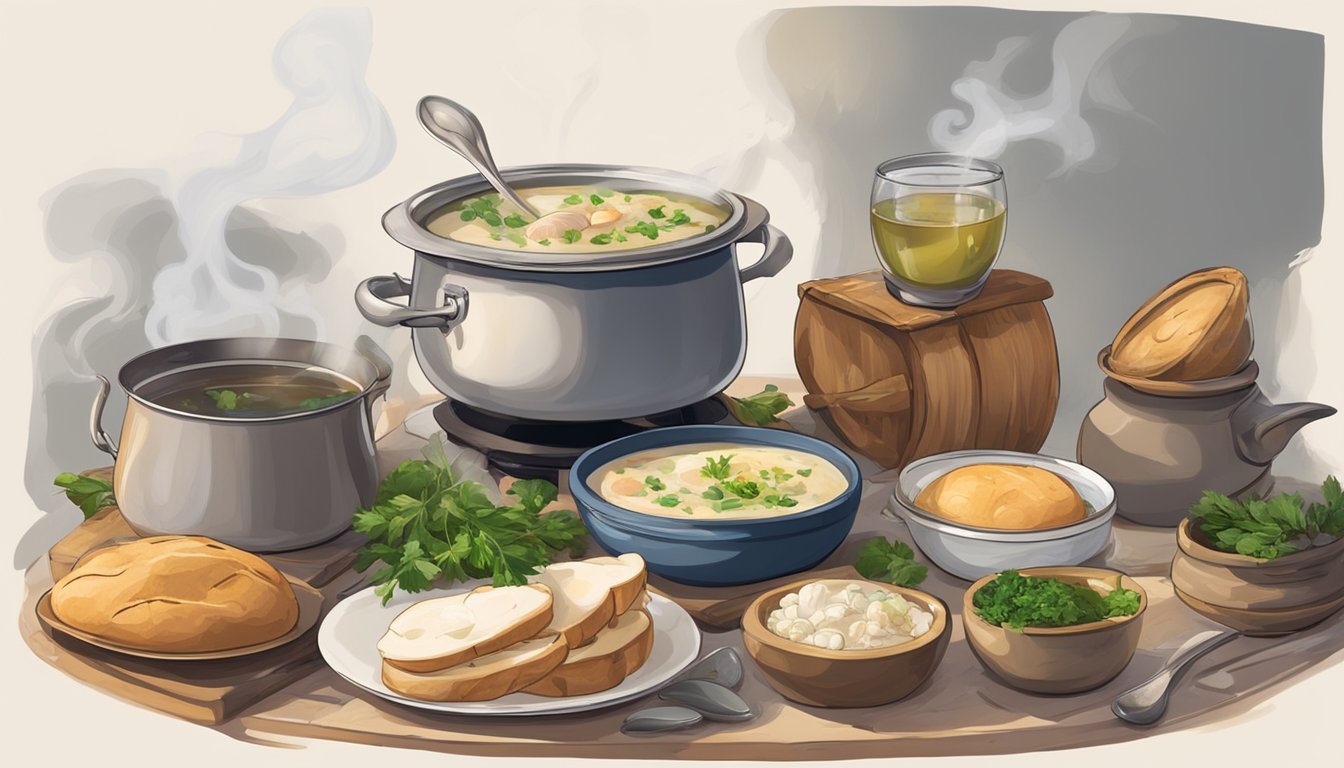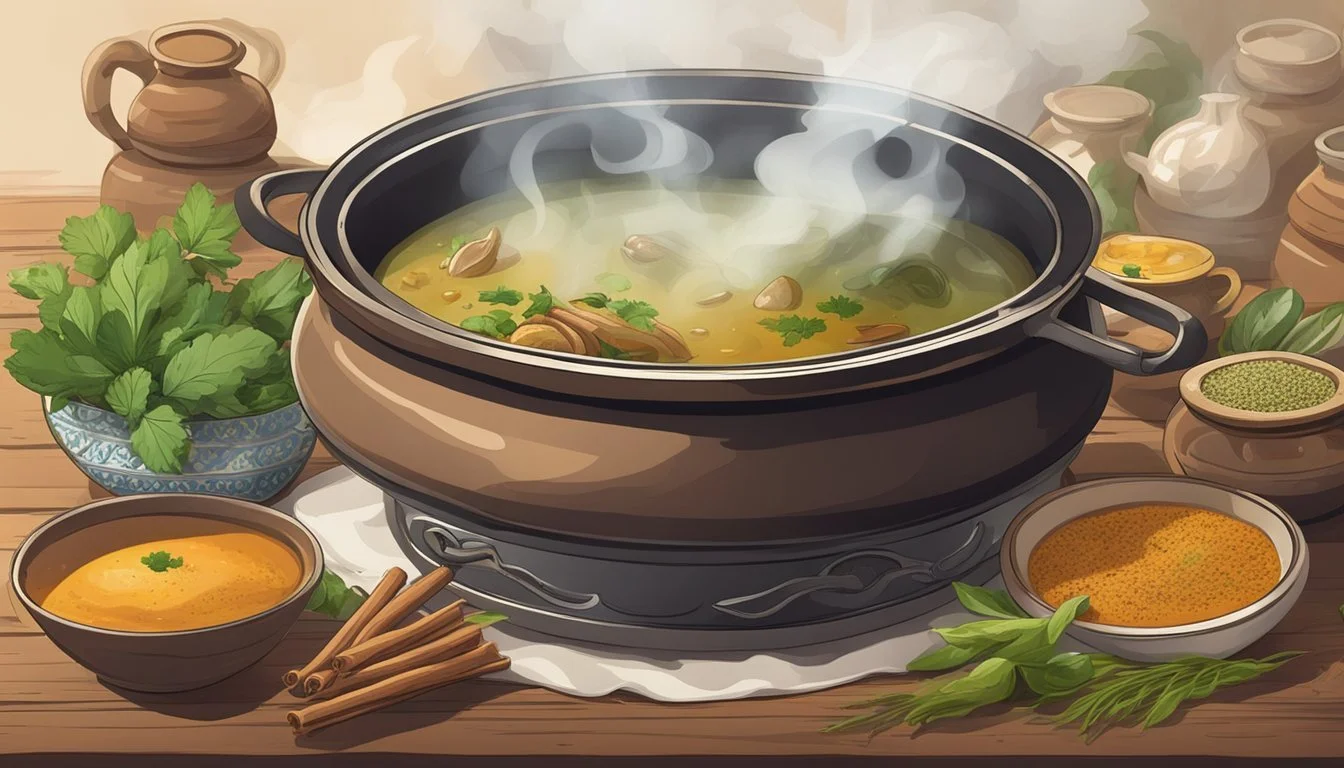Khash The Middle Eastern Delicacy - A Guide to Savory Boiled Cow Parts
Khash is a traditional Middle Eastern delicacy that has deep roots in Armenian culinary practices, though it is also enjoyed in other regional cuisines such as Georgian and Azerbaijani. This robust and hearty dish is revered for its simplicity and the depth of flavor it achieves using a select range of ingredients. At its core, Khash consists of boiled cow parts, which often include the head, feet, and stomach, known as tripe. Historically, it is consumed as a warming breakfast soup, especially during the colder months, and has a reputation as a remedy for hangovers.
The preparation of Khash is an overnight endeavor, signaling its place as a meal for special occasions or weekend gatherings. The parts of the cow used for Khash are meticulously cleaned and soaked in water to ensure a clear broth. The cooking process is a slow boil, often lasting several hours, which not only tenderizes the meat but also allows the full-bodied flavors to develop. A key characteristic of the soup is its unadorned nature—seasonings are minimal, sometimes limited to only salt and garlic, with diners given the option to add their choice of herbs and condiments.
The consumption of Khash is steeped in tradition and communal values. It is typically served with sides of vegetables and regional breads, like lavash, making the dining experience both a culinary and a cultural immersion. As Armenia's culinary footprint expands, Khash stands out as a testament to the region's rich gastronomic heritage and the shared joy of communal eating.
Historical Background
The history of Khash is deeply rooted in tradition, with origins tracing back to Armenian culture and spreading to neighboring Persian Gulf countries. Its medieval journey underscores not only its cultural significance but also provides insight into the dietary practices of the time.
Origins of Khash
Khash is a traditional dish that originated in Armenia, a country known for its rich culinary history. The exact beginnings are not well-documented, but it is believed to have been a resourceful way for the poor to use leftover animal parts that the wealthy did not consume. Cow or sheep feet, stomach, and even the head were boiled to create a nourishing meal that would otherwise have been wasted.
Khash in Medieval Armenia
In medieval Armenia, Khash evolved beyond a dish of necessity to become a wintertime staple and a communal meal, particularly appreciated for its warming properties. The preparation turned into a night-long endeavor, where the parts were simmered slowly until the broth became rich and the meats tender. This customary dish underscored the importance of frugality and community in medieval Armenian society, and was often consumed with accompaniments like garlic and lavash flatbread. Its consumption has persisted into the present day, where it is often enjoyed following festive occasions or as a hangover remedy.
Cultural Significance
Khash, a hearty and traditional dish rooted in ancient culinary practices, holds particular esteem within several Middle Eastern and Caucasian cultures. This dish not only serves as a comfort food but also embodies rich historical and cultural narratives.
Armenian Tradition
In Armenia, khash has evolved beyond a mere dish to represent a cultural practice deeply intertwined with social gatherings and rituals. Traditionally consumed in the colder months, specifically from late autumn to the end of winter, khash is often enjoyed during festive gatherings in the early morning. This Armenian dish is not merely about sustenance but also symbolizes communal unity, with families and friends partaking in the meal collectively.
Khash in Persian Gulf Culture
Countries in the Persian Gulf, including Kuwait and Bahrain, have incorporated khash into their culinary repertoire, adopting it with local variations. While less prevalent compared to its status in the Caucasian region, khash in these Arab countries signifies the assimilation of diverse influences within their gastronomy and displays the versatility of the dish as it transcends different cultures.
Iran and Iraq: Here, khash is accompanied by bread, radishes, and an array of herbs.
Egypt: While not central to Egyptian cuisine, dishes similar to khash can be found, showcasing the cross-cultural reach of this type of comfort food.
Khash Across Various Countries
Khash has made its way across various borders, adapting to local tastes while maintaining its core identity. For example:
Georgia: Known as khashi, it is embraced as part of the Georgian culinary culture, speaking to the dish's versatility and appeal.
Azerbaijan: Here, it's referred to as xaş and holds a special spot in Azerbaijani food (What wine goes well with Azerbaijani food?) traditions, similar to its Armenian counterpart.
Turkey, historically influenced by neighboring cuisines, sometimes sees khash-like preparations within its vast Turkish culinary culture.
The dish resonates with regional variations in countries like Albania, Greece, and amongst specific groups that appreciate offal-based meals.
Each country's take on khash underscores the dish's ability to migrate and adapt, emblematic of the interwoven histories and tastes in this geographically rich region.
The Dish Itself
Renowned in Middle Eastern cuisine, Khash is a nourishing dish often characterized by its long-simmered cow or sheep parts. This traditional meal boasts a gelatinous consistency, attributed to the boiling of connective tissues.
Defining Khash
Khash is a rich, savory soup-like dish that involves the thorough boiling of cow or sheep offal. Typically, the key components of this dish are the head, hooves (trotters), stomach (tripe), and occasionally other meaty scraps. This process leads to a hearty and gelatinous consistency that is both warming and typically consumed during the colder months.
Typical Ingredients and Preparation
A traditional khash recipe comprises several essential ingredients and follows a specific preparation method:
Meat: Both cow and sheep parts can be used, with a preference for head, trotters, and stomach.
Seasonings: While the soup is noted for its simplicity, it is often seasoned with salt, garlic, and sometimes additional spices.
Supplementary Ingredients: Onions (What wine goes well with onions?) are commonly included during boiling to add flavor.
Preparation involves rinsing the meats thoroughly and then simmering them over a low heat for several hours until tender. Some recipes require pre-boiling to remove impurities:
Steps: Cleaning and Soaking
Description: Offal is rinsed and soaked to remove any residues.
Steps: Boiling
Description: Ingredients are boiled to achieve the desired gelatinous texture.
Steps: Skimming
Description: The top is frequently skimmed to ensure a clear broth.
Steps: Serving
Description: Khash is typically served hot with a side of minced garlic and vinegar.
Variations by Region
Across different regions where Khash is enjoyed, slight variations of the dish can be observed:
Armenia: Often recognized as the dish's origin, Armenians typically consume khash with a side of lavash (flatbread) and condiments like garlic and vinegar to enhance the flavor.
Georgia: In Georgia, the recipe is known as khashi.
Iran: Here, the dish might also include additional spices and be referred to with different names based on its ingredients.
In all its regional forms, Khash remains a cornerstone dish, especially in winter, revered for its comforting qualities and the communal aspect of its enjoyment.
Preparation Techniques
Preparing Khash involves a meticulous process that centers on slowly boiling and simmering specific parts of cow or sheep to create a nourishing broth.
Cooking Process
The cooking process begins by thoroughly cleaning and soaking the main ingredients—typically cow or sheep feet and occasionally stomach (tripe)—to rid them of impurities. Soaking is done in cold water, preferably refrigerated, for 10 to 48 hours, with the water being changed every few hours during the initial period.
After soaking, the pieces are placed into a large pot and covered with water. Traditionally, the water level should be about 2 inches above the bones and parts. The contents are then brought to a boil and eventually reduced to a simmer. This slow cooking method, which can last overnight, allows the rich flavors to develop and the gelatinous textures to form, hinging on the collagen released from the bones and hooves.
Garnishes and Accompaniments
Khash is customarily served with a variety of garnishes and accompaniments that enhance its flavor and provide a balance to its rich broth. Common garnishes include:
Lemon: To add a fresh citrus note;
Garlic: Often crushed or minced for pungent warmth;
Radishes: Providing a peppery crunch;
Parsley and Cilantro: Fresh herbs for an aromatic touch;
Pickles: For a tangy counterpoint.
As for accompaniments, the soup is traditionally paired with lavash or other forms of flatbread. These breads serve to sop up the broth, creating a complete meal. In addition, a side salad with onions is frequently served to compliment the hearty flavors of the dish. Notably, Khash is appreciated across various cultures, including Persian, Afghan, Bosnian, and those of the South Caucasus—each adding its own regional twist to the preparation and presentation.
Serving and Consumption
In the rich tradition of the Middle Eastern cuisine, Khash is revered for its hearty flavors and communal serving. Consumption typically involves both morning rituals and toasts, underscoring its cultural importance.
Traditional Serving Methods
Khash is traditionally served as a hot broth early in the morning. The soup, rich in gelatin and fat, is often accompanied by sides of crisp, lavash flatbread, crushed garlic, and pickled vegetables. (What wine goes well with pickled vegetables?) Presentation is straightforward; diners are given a bowl of the clear soup, usually abundant in protein, and people customize their portions using the various accompaniments.
Toast and Rituals
Consumption of Khash is not just a meal but an event, especially in Armenia. Their customary ritual begins with a toast, often with vodka, to health and good company. It’s common for people to squeeze lemons into their soup for a burst of flavor. The toast is a significant part of the dining process, featuring prominently during the meal.
Health and Nutritional Aspects
While Khash is lauded for its taste, it is also recognized for potential healing properties. The broth is high in collagen and other nutrients derived from the slow-cooked cow parts. It's believed to aid in gut healing and bone health. However, due to its high fat content, it is quite rich and is therefore recommended to be consumed in moderation.
Global Influences and Similar Dishes
Khash, a dish deeply rooted in tradition, shares its fundamental concept with various other cultural specialties around the world. While distinct in their preparation and spices, these dishes reveal a common appreciation for utilizing all parts of the animal.
Dishes with Resembrace to Khash
Middle Eastern and Asian Delicacies:
Pacha: A similar Iraqi dish that includes boiled sheep's head and trotters.
Kalle-pache: This dish is consumed in countries like Iran, comprising sheep's head and feet.
Paya: A South Asian subcontinent variant, with spiced cow or goat trotters.
Soğuk paça: A Turkish version often served cold.
European Variations:
Hough: In Scotland, a dish made by slow-cooking the lower shin of beef with a resulting gelatinous texture.
Svið: An Icelandic dish that features a singed sheep's head split in half.
Tête de veau: French cuisine occasionally presents dishes like this one, employing the head of a calf.
Khash's Influence in Culinary Practices
Regional Integrations:
Greece and the Balkans: Restaurants known as patsatzidika specialize in tripe-related dishes, showcasing the influence of similar traditional foods like Khash.
Albania and North Macedonia: These countries house culinary practices in which offal-based delicacies are prevalent, demonstrating Khash’s conceptual influence.
Bold and earthy, these dishes are not for the faint of heart but are celebrated for their rich flavors and cultural significance. Whether it's in the bazaars of Yerevan or the street corners of Istanbul, delicacies such as Khash testify to a universal culinary principle: the resourceful and respectful use of the entire animal.
Etymology and Language
Understanding the etymology of the dish's name provides insight into its cultural significance and preparation. The dish is steeped in tradition and linguistics, reflecting its origins and how it is interwoven with the language of the region.
Terminology of Khash
Khash originates from Armenian, where it is known as խաշ (xaš). The term is derived from the Armenian verb xašel (խաշել), which means "to boil." This etymology indicates the primary cooking method employed in the dish's preparation.
Throughout different regions, khash has known variations such as khashi in Georgian (ხაში) and xaş in Azerbaijani. Each variation ties the dish to its respective culture through linguistic connections.
While the dish does not directly relate to spirits like vodka or wine, it is commonly consumed with these beverages in social settings. Accompanied by drinks, khash is generally served with red wine vinegar and avgolémono, a Mediterranean sauce made from eggs, lemon juice, and broth. These accompaniments are essential to the dish's enjoyment and are often highlighted during toasts and communal gatherings.
Khash in the Modern Era
In the present day, khash remains a cherished dish, embraced in restaurants and innovated through fusion trends, reflecting its enduring cultural significance and adaptability.
Contemporary Khash Restaurants
Contemporary Khash Restaurants serve the traditional Armenian khash with great reverence to authenticity. Patrons typically find cow feet or hooves and, on occasion, calf parts as fundamental ingredients in the hearty broth. The dish is often accompanied by lavash (a thin Armenian flatbread), lemons for a tangy zest, and sometimes even a shot of vodka to complement the rich flavors. Restaurants specializing in khash usually open early, as the dish is most commonly consumed as a heavy breakfast, thought to be beneficial after a night of drinking.
Menu Example:
Dish: Armenian Khash
Ingredients: Cow feet, tripe, garlic
Accompaniments: Lavash, lemons, vodkaRevival and Fusion Trends
The Revival and Fusion Trends in khash reflect a blend of tradition and modernity. Chefs are experimenting by incorporating the fundamental elements of khash into new culinary creations. Some restaurants now offer khash-inspired soups, and others serve deconstructed versions with carefully plated components. Fusion has led to offerings of khash with non-traditional spices or vegetables, thus broadening its appeal to a wider audience. Yet, these trends maintain a core respect for the dish's origins, ensuring that the fusion does not overshadow the rich cultural heritage of khash.
Conclusion
Khash, a culinary tradition deeply rooted in Armenian culture, has its origins traced back to Medieval Armenia. Revered for its simplicity and nourishing qualities, it embodies the resourcefulness of traditional cooking. The dish, typically prepared with bovine or ovine parts, such as the head, stomach, and feet, is often associated with social and family gatherings, persisting as a cornerstone within the Armenian culinary heritage.
In a modern context, khash maintains its ceremonial significance, often consumed during the colder months or as a reputed hangover remedy. It acts as a cultural bridge, connecting the past with the present while inviting culinary enthusiasts to partake in an ancient practice. This communal breakfast dish is traditionally served with sides of garlic, radishes, pickles, and essential condiments like salt and vinegar.
Evolving from a meal of necessity to one of nostalgic indulgence, khash remains a testament to the resilience and continuity of Armenian food (What wine goes well with Armenian food?) culture. It is a dish celebrated for its hearty and distinct flavors, as well as its capacity to gather people around a shared table. Enjoyed by many in the region, khash has firmly positioned itself as a cherished staple in the Middle Eastern gastronomic scene.

